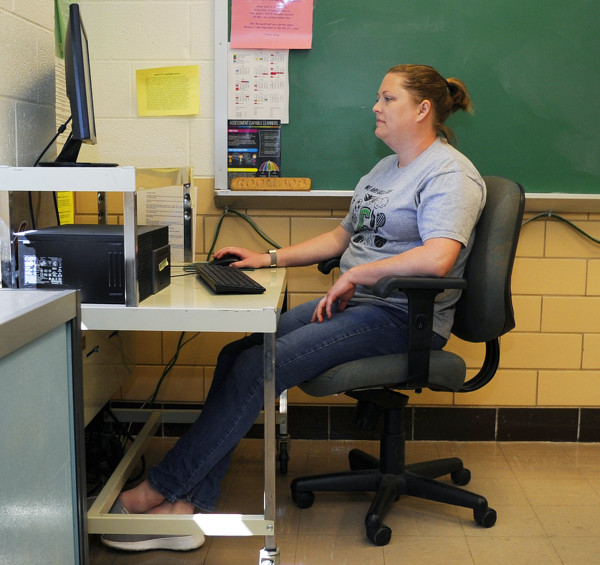Tuesday, May 5th, 2020
Teachers adapt to new normal
By Sydney Albert

Photo by Dan Melograna/The Daily Standard
Andrea Graves, who teaches algebra 2 and senior math at Celina High School, checks on Monday morning to see if any students have emailed questions about assignments.
ST. MARYS - When Gov. Mike DeWine first ordered schools to switch to remote learning, Amy Wenning had thought it would last only a few weeks.
The fourth-grade math teacher at West Intermediate School in St. Marys, along with other teachers, put together assignments for her students - just enough to get them through the initial period.
As the remote-learning mandate was extended, though, Wenning realized she had to do more. She began planning Zoom online meetings with her fourth-graders and working to make herself available to properly instruct them and answer questions, but teaching remotely is not as easy as it may sound.
In the last semester, teachers all over the state have had to figure out how to keep kids from falling behind when they're unable to meet with their pupils every day in the classroom. While some have had an easier time than others, whether due to available technology or the ages of their students, several teachers agree on one thing: they want to be back in school.
Jen Van Gundy, a second-grade teacher in St. Marys, was very skeptical when she first heard of the remote learning mandate. Her students were young and tended to do more hands-on activities in class. The one-to-one program, which gives a laptop to every student, is available only to older students, and Van Gundy worried about how some students would be able to access the internet.
In response, she has relied on physical work packets. Students take the packets home to complete and return, and while extra study materials are available online, they are not mandatory.
Polly Walters, a St. Marys eighth-grade English teacher, said the mandate had come as a shock, but she immediately began thinking about the logistics of what needed to be done.
On the last day in class with her students, Walters gave them the materials they would need and took the time to answer any questions. Instead of celebratory reactions, she remembers students being confused.
She said she's sure some students initially kicked back a bit on their studies. However, while they probably thought the break from the classroom meant an "extended spring break." Reality didn't pan out as they had thought. They were not able to hang out with friends or visit relatives, and Walters has found her kids seem to miss the social benefits of school at least as much as the educational benefits.
One of the first assignments Walters gave her students was to write about what they missed the most. Some responses brought her to tears.
"They missed us as much as we missed them. And they missed funny things, like - not funny things, but expected things, like the support of our instruction, right? They missed some things that we do naturally as teachers to make them know and realize, not only we love what we do, but we value and appreciate them and respect them and understand the different homes that they come from," Walters said.
Some students had even written about missing their teachers' nagging, she said, laughing.
Van Gundy said her second-graders had also discussed missing school. She writes letters to her students every week, and some reply, telling her what they're doing. They often talk about how they miss school and want to go back.
Zoom has proven to be critical for teachers trying to keep in contact with their students and for allowing classmates to interact. Van Gundy said Zoom has become a class favorite, allowing her students to see their friends and perform more regular class activities such as show and tell. Still, it doesn't replace being in the classroom.
Part of Wenning's challenge has been arranging Zoom meetings around families' different schedules. Every student has a unique situation. Some parents may work all day with their child at home. For some, schoolwork and Zoom meetings with teachers aren't the priority - tending to life's necessities is.
Wenning said she feels like her hours have been incredibly scattered since remote learning became necessary. She works all day to make herself available to her students, though she is also getting time at home with her own family.
Plenty of her fourth-graders are tech savvy, but students don't always have the time to be on the computer for classes. If a family has only one device, multiple siblings could be trying to use it to get classwork done, Wenning said. She has tried to come up with alternative, off-screen assignments to help ease the problem.
Getting in touch with parents and students has been a challenge at times due to varying levels of access to technology, Walters said. When she doesn't hear from one of her eighth-graders for a while, she worries and reaches out.
While all families have been kind and grateful during these unprecedented times, Walters said some have admitted to enduring hardships.
The middle school staff have worked to make unused devices available to families in need. It's helped some - students who were previously struggling to type up essay responses on their phone are doing much better, she said.
In some situations, though, Walters has reminded students that other needs during this pandemic may be more of a priority than schoolwork. Still, consistency can be therapeutic, and schoolwork can give students something on which to focus. She encourages them to try to complete theirs whenever they can.
Walters said her work/life balance has also changed since remote learning began. She believes she is investing more time working outside of the classroom than she ever was when she was in the school building. Whereas most of her job had been centered around instructing her students, now a bulk of her day is contacting them and their parents, scheduling Zoom meetings for reading comprehension tests and the like.
It's been "terribly difficult," she continued, saying she couldn't imagine a teacher on the planet who wouldn't trade one day of remote learning for the worst day of in-person instruction.
Wenning said the arrangement is difficult for parents too, but they had largely been supportive or at least understanding of the unique situation. Van Gundy noted several parents had asked what more they could do for their kids and saluted the many parents who work full time and are also acting as part-time teachers.
Everyone has experienced his or her own hardships during this pandemic, Walters said, but in the bigger picture, she believes measures such as remote learning were necessary. Better to endure than lose things that couldn't be replaced such as human lives, she added.
She also hoped that, when students return to their classrooms they would have a new appreciation for school and education.

